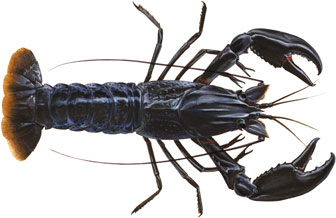
Marron are the largest freshwater crayfish in Western Australia – and the third largest in the world.
They are endemic to south-west WA and fishing for them has long been a WA tradition.
A marron has a head and thorax protected by a hard shell called a carapace, and a muscular abdomen and tail.
Marron belong to the genus Cherax within the Parastacidae family. They are decapod crustaceans, which means they have 10 legs. These include large claws for grasping food, fighting and moving. The next pair of legs consists of two small pincers for picking up food particles and stuffing them in their mouths.
Marron have two eyes on the end of eyestalks but also rely heavily on touch and taste, using one pair of large antennae and smaller antennules. They are most active just after sunset.
Marron can grow to more than 380 mm in total length. They range in colour from jet-black to brown or even striped, red and cobalt-blue, a rare natural version now farmed for aquariums.
Distribution and habitat
Marron are endemic between Harvey and Albany. Over the past century, marron were stocked into farm dams and waterways from Hutt River north of Geraldton inland to the WA Goldfields and east to Esperance on the south coast. They have also been stocked into commercial aquaculture farms in South Australia.
Marron don’t thrive in water with high salinity, low oxygen or high temperatures. They prefer to live in parts of rivers and dams where there is permanent water and plenty of suitable habitat and food, such as rivers and dams containing fallen trees and submerged leaves.
Destruction of riverbank vegetation, increasing salinity, climate change and reduced river flow are affecting all of south-west WA’s freshwater systems.
In response to these environmental pressures, marron have reduced their range within rivers. The healthiest populations are generally found in rivers that are still largely in their natural state, with well-forested catchments and plenty of vegetation on the banks.
Types of marron
Two types are found in WA: hairy marron (Cherax tenuimanus) and smooth marron (Cherax cainii).
Smooth marron are found in most south-west rivers and dams. They are what most marroners have seen and captured, and are the farmed aquaculture species.
Hairy marron are listed as critically endangered and only found in the upper reaches of Margaret River. (The head and sometimes tail (of larger marron) are covered in short hairs.)
Lifecycle
Juvenile marron are rarely seen. They hide under rocks and in forest litter on the river or dam bed. The speckled colouring that camouflages them changes as they grow older.
Marron grow mostly in summer, when water temperature is warmest. They grow by moulting (shedding their shell, exposing a larger shell, which had been forming underneath). During the short time the new shell takes to harden, marron are especially vulnerable to attack. In winter, with cooler water temperatures, marron are less active and their growth rate slows.
They reach sexual maturity at two to three years of age. They spawn in early spring when water temperatures start to rise and in favourable seasons will produce more eggs (usually between 200 and 400, but large females may produce up to 800). The eggs take nearly half a year to develop inside the females. During mating, the males pass on a sperm packet that the females use to fertilise their eggs after laying.
Once the eggs are fertilised, the females carry them in a large mass under the tail until they hatch in late spring. The hatched larvae then hang under the mother’s tail, clinging to fine hairs. They stay there for many weeks, feeding on nutrients from the yolk sac and moulting several times.
By summer, these tiny juveniles are ready to actively feed. They drop away from their mother and remain in waterways close to where they were hatched.
Diet
Marron play a critical role as recyclers, breaking down animal and plant matter. Marron eat living, dead and decaying plant and animal material found on the river or dam bed, including small invertebrates, fish eggs, fish larvae and algae.
Predators
They are preyed upon by native water rats, tortoises, birds such as cormorants, fish such as freshwater cobbler and introduced species such as redfin perch and trout. Small juveniles are highly vulnerable to predation from other fish and animals, and cannibalism by larger marron.
Illustration © R. Swainston/www.anima.net.au